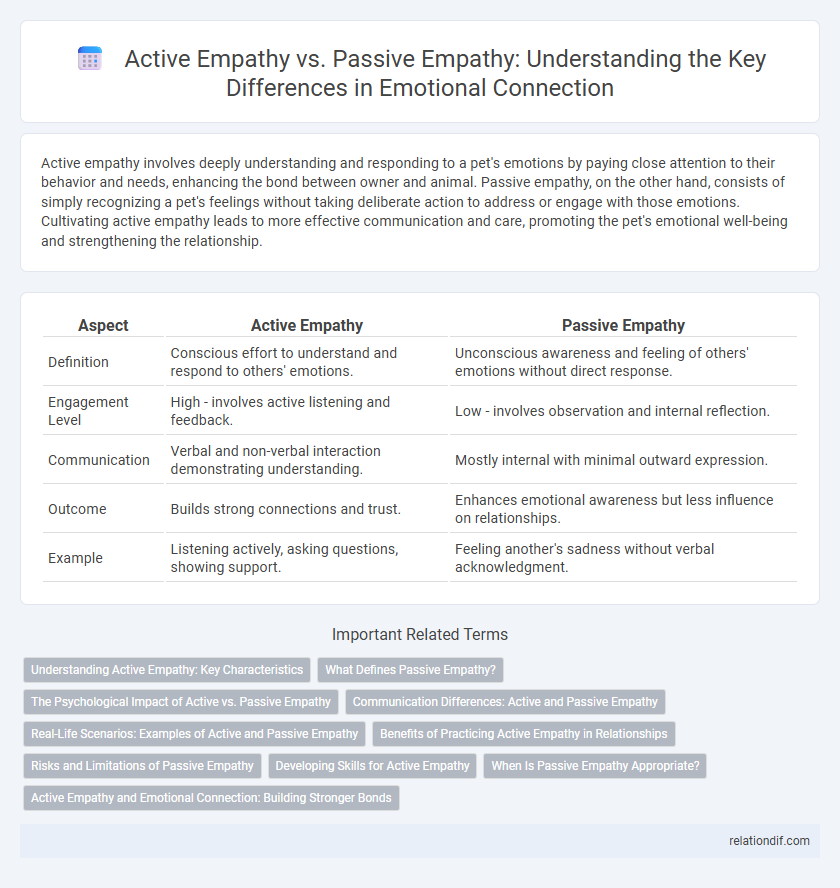Active empathy involves deeply understanding and responding to a pet's emotions by paying close attention to their behavior and needs, enhancing the bond between owner and animal. Passive empathy, on the other hand, consists of simply recognizing a pet's feelings without taking deliberate action to address or engage with those emotions. Cultivating active empathy leads to more effective communication and care, promoting the pet's emotional well-being and strengthening the relationship.
Table of Comparison
| Aspect | Active Empathy | Passive Empathy |
|---|---|---|
| Definition | Conscious effort to understand and respond to others' emotions. | Unconscious awareness and feeling of others' emotions without direct response. |
| Engagement Level | High - involves active listening and feedback. | Low - involves observation and internal reflection. |
| Communication | Verbal and non-verbal interaction demonstrating understanding. | Mostly internal with minimal outward expression. |
| Outcome | Builds strong connections and trust. | Enhances emotional awareness but less influence on relationships. |
| Example | Listening actively, asking questions, showing support. | Feeling another's sadness without verbal acknowledgment. |
Understanding Active Empathy: Key Characteristics
Active empathy involves fully engaging with another person's emotions by listening attentively, asking clarifying questions, and responding thoughtfully to demonstrate genuine understanding. It requires conscious effort to validate feelings and provide support, fostering deeper emotional connection and trust. Unlike passive empathy, which is more observational, active empathy drives meaningful interpersonal communication and promotes emotional healing.
What Defines Passive Empathy?
Passive empathy is defined by an individual's ability to understand and share another person's feelings without actively engaging or responding to those emotions. It involves quietly recognizing emotional states and offering mental acknowledgment rather than verbal or physical support. This form of empathy often lacks the intentional actions seen in active empathy but still fosters emotional connection through attentive observation.
The Psychological Impact of Active vs. Passive Empathy
Active empathy involves consciously engaging with another person's emotions and experiences, fostering deeper psychological connection and emotional validation. Passive empathy, characterized by a more detached acknowledgment of others' feelings, may result in limited emotional resonance and reduced psychological support. Research indicates that active empathy enhances emotional regulation, reduces feelings of isolation, and promotes psychological resilience more effectively than passive empathy.
Communication Differences: Active and Passive Empathy
Active empathy involves engaging deeply with another person's emotions through attentive listening and reflective responses, enhancing mutual understanding and emotional connection. Passive empathy, by contrast, entails recognizing and internalizing someone else's feelings without verbal engagement or interactive feedback, often resulting in less effective communication. Effective communication requires active empathy to foster genuine dialogue and resolve misunderstandings, as passive empathy may lead to emotional distance and missed cues.
Real-Life Scenarios: Examples of Active and Passive Empathy
In real-life scenarios, active empathy involves consciously listening, asking clarifying questions, and offering support, such as helping a colleague brainstorm solutions during a work crisis. Passive empathy is exemplified by simply acknowledging a friend's feelings without further engagement, like nodding in understanding when they share their struggles. Active empathy fosters deeper connection and problem-solving, while passive empathy provides emotional validation with less interactive involvement.
Benefits of Practicing Active Empathy in Relationships
Practicing active empathy in relationships fosters deeper emotional connections by fully engaging with others' feelings and perspectives, leading to enhanced trust and communication. It promotes conflict resolution through understanding and validation, which strengthens bonds and reduces misunderstandings. Active empathy also encourages emotional support and responsiveness, contributing to healthier, more resilient relationships.
Risks and Limitations of Passive Empathy
Passive empathy often risks superficial understanding, as it involves feeling for others without deeply engaging with their experiences, which can lead to misinterpretation and lack of meaningful emotional support. This limited engagement may cause emotional burnout or compassion fatigue, as individuals fail to set boundaries or process their empathetic responses effectively. Moreover, passive empathy can reinforce emotional distance, preventing genuine connection and hindering effective communication in personal and professional relationships.
Developing Skills for Active Empathy
Developing skills for active empathy involves intentional listening, where one fully concentrates on the speaker's words, emotions, and underlying needs, rather than just passively acknowledging them. Practicing reflective responses and asking clarifying questions enhances understanding and validates the speaker's feelings, fostering deeper emotional connections. Training in perspective-taking exercises strengthens the ability to genuinely share and respond to others' experiences, which is essential for active empathy.
When Is Passive Empathy Appropriate?
Passive empathy is appropriate in situations where emotional support is needed without direct intervention, allowing individuals space to process feelings independently. It suits environments like casual conversations or when someone seeks validation rather than advice, fostering a non-intrusive presence. Recognizing cues for passive empathy enhances interpersonal connections by respecting emotional boundaries while maintaining understanding.
Active Empathy and Emotional Connection: Building Stronger Bonds
Active empathy involves consciously engaging with another person's emotions through attentive listening, validating feelings, and responding thoughtfully, which fosters a deeper emotional connection. This deliberate practice strengthens interpersonal bonds by creating an environment of trust and understanding, essential for effective communication and relationship growth. Studies show that active empathy enhances emotional intelligence and promotes resilience in personal and professional relationships.
Active empathy vs passive empathy Infographic

 relationdif.com
relationdif.com